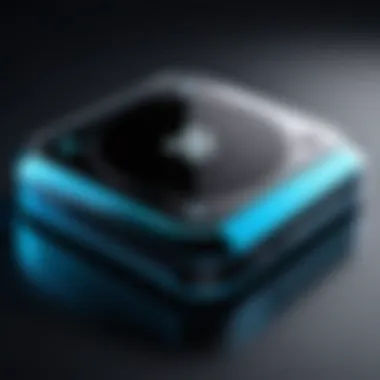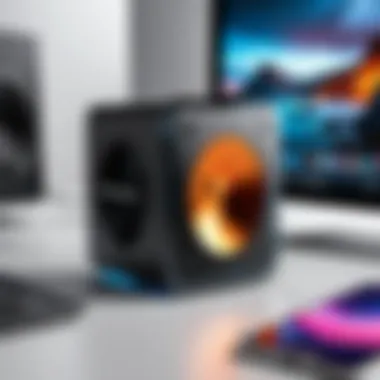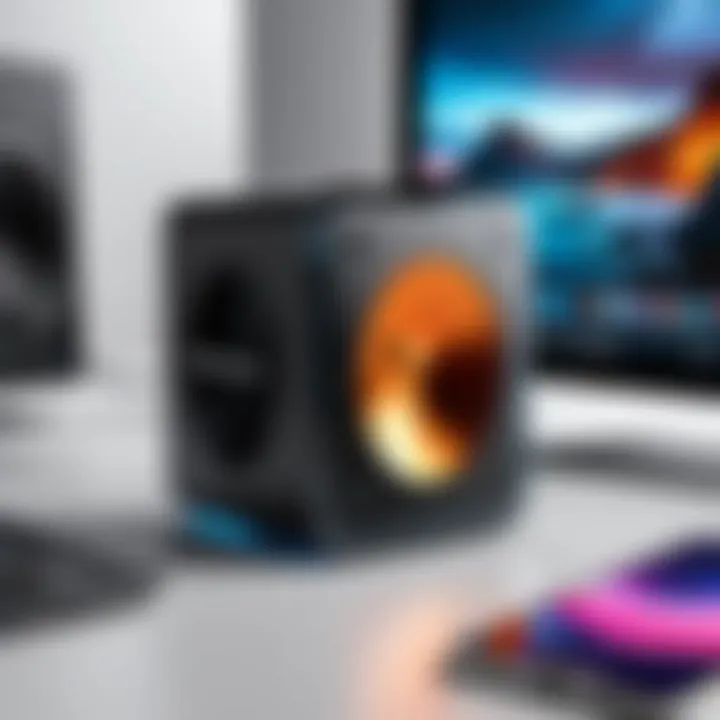Exploring Bluetooth Music Storage Devices: A Comprehensive Guide


Intro
Bluetooth music storage devices have secured a meaningful place in today's audio landscape. With the evolution of music consumption habits, these devices provide an essential solution for both storage and playback convenience. They allow users to wirelessly access their favorite tracks while providing sufficient storage capacity for extensive libraries. Understanding the features, specifications, and functionality of these devices can enhance the listening experience for tech-savvy individuals and casual users alike.
Each device offers distinct functionalities and benefits that appeal to various user preferences. For instance, some prioritize portability, while others focus on higher storage capacities or advanced features like voice commands. This guide aims to provide a detailed examination of these devices, ensuring readers can make informed choices amidst a wide range of options.
Key Features
Design and Build Quality
The design and build quality of Bluetooth music storage devices play a crucial role in user experience. Many models use premium materials that enhance durability and aesthetics. Lightweight designs make these devices more portable, which is essential for music lovers on the go. Additionally, water-resistant and dustproof features can be found in certain models, making them suitable for various conditions and environments.
Display and Performance
A multitude of Bluetooth devices now includes user-friendly displays. These displays can show track information, battery life, and connectivity status. Performance wise, the audio quality can vary significantly among devices. It's important to consider sound clarity and range. Some devices also feature equalizers or preset modes to enhance the listening experience based on user preferences.
Product Specifications
Technical Specifications
Understanding technical specifications is essential for evaluating Bluetooth music storage devices. Look for details like audio codecs supported, which can include SBC, AAC, and aptX. Battery life is another critical specification to consider, as it determines how long the device can be used continuously.
Compatibility and Connectivity
Compatibility with various platforms is fundamental to the utility of Bluetooth devices. Most can connect seamlessly with smartphones, tablets, and computers. Furthermore, the ease of pairing and reconnecting serves as a significant advantage for users. Many devices also support multi-connection capabilities, enabling simultaneous connections to more than one device.
"With the right Bluetooth music storage device, your music can follow you anywhere, breaking free from the limitations of traditional formats."
Prelude to Bluetooth Music Storage Devices
Bluetooth music storage devices play a pivotal role in today’s audio landscape, reshaping how we interact with music. The growing reliance on these devices underlines the importance of understanding their functions and benefits. As technology advances, the demand for seamless and efficient music storage solutions is evident. Bluetooth technology allows for wireless transmission, empowering users with enhanced mobility and flexibility.
An increasing number of individuals are investing in Bluetooth music storage devices due to their convenience. This segment of audio technology eliminates the clutter of wires, integrates easily with various digital platforms, and supports diverse formats of music storage.
Defining Bluetooth Technology
Bluetooth is a wireless technology standard used for exchanging data between devices over short distances. It operates in the 2.4 GHz ISM band. This technology facilitates low-power, secure communication, thus making it ideal for audio streaming. The idea of Bluetooth emerged in the early 1990s, aiming to replace RS-232 data cables. Over the years, Bluetooth has evolved, and its applications have extended far beyond simple data exchange. With versions improving speed and range, it now supports a range of devices, particularly in the audio domain.
When discussing Bluetooth in the context of music storage devices, it becomes crucial to understand profiles. These profiles determine how devices communicate. The Advanced Audio Distribution Profile (A2DP), for example, is essential for streaming high-fidelity audio.
Understanding Music Storage
Music storage refers to the methods and devices used to save and access audio files. As digital formats have become dominant, the methods of storage have evolved tremendously. Initial formats such as CDs and cassettes are increasingly being replaced with digital files stored on hard drives, cloud services, and dedicated music storage devices.
Various formats, including MP3, AAC, and FLAC, cater to different needs, balancing file size and audio quality. Modern Bluetooth music storage devices often come with built-in storage capabilities and support streaming from cloud services, providing users with endless access to their favorite tracks. The integration of storage options with Bluetooth technology enhances user experience, making access and management of music more efficient.
Types of Bluetooth Music Storage Devices
Understanding the various types of Bluetooth music storage devices is crucial for anyone looking to enhance their audio experience. These devices come in multiple forms, and each serves a unique purpose, catering to different listening preferences and needs. Whether you are an audiophile seeking superior sound quality or a casual listener needing convenience, there’s a Bluetooth device to match. Here, we will explore three primary categories: Bluetooth speakers, Bluetooth headphones, and Bluetooth adaptors.
Bluetooth Speakers


Bluetooth speakers have gained popularity due to their ability to deliver sound in a portable format. They are designed for users who enjoy music indoors and outdoors. The convenience of wireless connectivity makes them appealing. Users can connect their smartphones or laptops without the hassle of cords. The audio quality from these speakers can vary significantly.
Most models provide a decent level of sound clarity, but higher-end speakers deliver richer bass and crisp treble. Popular brands, like Bose or JBL, focus on producing sound that is both powerful and compact. When selecting a Bluetooth speaker, consider battery life, as this will determine how long you can use it before needing a recharge. Some speakers are also water-resistant. This feature is particularly vital for outdoor usage.
Bluetooth Headphones
Bluetooth headphones cater to individuals who prefer personal listening experiences. They eliminate the need for wires, finishing the frustration of tangled cords. There are generally two types: on-ear and in-ear. Each type offers various benefits.
On-ear headphones tend to provide a more immersive sound experience, suitable for at-home listening. In contrast, in-ear options are smaller and more portable, making them ideal for travel or exercise. Brands like Sony and Apple are well-known for their innovative headphone designs, providing noise cancellation options that enhance audio enjoyment. Additionally, look for features like battery life, comfort, and sound quality when making your choice.
Bluetooth Adaptors
Bluetooth adaptors are essential for integrating non-Bluetooth devices into the wireless ecosystem. These small devices allow you to connect older stereo systems or non-Bluetooth speakers to your smartphone or tablet. They work by converting audio signals from the source device into Bluetooth signals. Most adaptors connect through the audio jack or USB port.
While they may lack the advanced features of dedicated audio devices, they serve a critical role in expanding the usability of your existing audio equipment. When considering adaptors, check for compatibility with both your existing systems and the latest Bluetooth technology for the best performance.
"Bluetooth music storage devices enhance both portability and accessibility, merging traditional audio formats with modern technology."
How Bluetooth Music Storage Devices Work
Understanding how Bluetooth music storage devices function is crucial for anyone looking to maximize their audio experience. These devices are engineered to handle the storage and transmission of digital audio wirelessly, allowing users to enjoy music without the constraints of cords. Let’s break down these functions into specific areas for clarity.
The Role of Compression Algorithms
Compression algorithms are foundational to the efficient operation of Bluetooth music storage devices. They reduce the file sizes of audio tracks, which is essential for maintaining enough storage while ensuring quality playback. Without compression, high-quality audio files would take up significant storage space, limiting the number of songs that can be stored.
Algorithms like MP3, AAC, and aptX are commonly used within these systems. Each has its own method of balancing quality and size. For example, while MP3 is widely recognized and supported, AAC provides better quality at lower bit rates, making it preferred in devices like Apple's AirPods. The role of these algorithms cannot be understated; they facilitate quicker transmission rates and also enhance user experience by reducing buffering issues associated with larger files.
Signal Transmission and Range
The next essential aspect is signal transmission and range. Bluetooth technology operates within a specific frequency range, typically around 2.4 GHz. This frequency band helps ensure a relatively stable connection. However, the effective range can vary based on various factors.
On average, the range for many Bluetooth devices is about 10 meters, although this can be affected by physical obstructions like walls or interference from other electronic devices.
In particular, advancements in Bluetooth versions, like Bluetooth 5.0 and 5.1, increase both the range and speed of data transfer. This is critical for users seeking uninterrupted audio experiences. For instance, the improved range allows users to move freely within their space while maintaining a quality connection. Both elements of signal transmission and range significantly impact the overall performance and utility of Bluetooth music storage devices, making them more versatile and user-friendly.
Key Takeaway: Compression algorithms are pivotal in managing file sizes and quality, while effective signal transmission enhances user mobility and audio experience.
Overall, understanding these functions equips users with the knowledge to make more informed decisions when choosing Bluetooth music storage devices. Whether prioritizing audio quality, mobility, or functionality, comprehending these elements helps in selecting equipment that best meets individual needs.
Benefits of Using Bluetooth Music Storage Devices
The rising popularity of Bluetooth music storage devices offers several significant advantages. These benefits are crucial to understanding how these devices shape the audio experience. With convenience and portability at the forefront, users can easily access and enjoy their music anywhere. The integration of wireless technology further enhances freedom of movement, making these devices an appealing option for various lifestyles.
Convenience and Portability
Convenience is a primary advantage of Bluetooth music storage devices. Unlike traditional wired systems, users do not have to deal with tangled cords or limited movement. They can gather and carry their music collections effortlessly. For individuals who enjoy exercising, Bluetooth headphones, for example, provide the ability to listen to music while moving freely without being hindered by wires. This convenience extends to everyday activities, such as commuting or traveling, where space and portability are often limited.
Moreover, many of these devices are lightweight and compact. Bluetooth speakers can easily fit into bags, making it possible to enjoy music outdoors or during social gatherings. The simplicity of connection adds to the convenience—pairing devices usually requires just a few taps, removing the need for complex setups. As a result, users often find themselves with increased access to music, enhancing their daily routines.
Wireless Technology and Freedom of Movement
Wireless technology represents another major benefit of Bluetooth music storage devices. This freedom of movement allows users to connect to their music sources from considerable distances. For instance, with a Bluetooth speaker, one can control playback from across the room without being tethered by cables. This flexibility is particularly useful during gatherings, where guests can move around and participate in conversations without losing audio quality.


The absence of physical connections also means less wear and tear on devices. Users are less likely to experience frayed chords or damaged ports compared to traditional wired equipment. The resilience of wireless technology can lead to longer product lifespans, which is a win for both users and manufacturers.
Considerations When Selecting Bluetooth Music Storage Devices
When selecting Bluetooth music storage devices, it is essential to consider several factors that may impact both functionality and user experience. These considerations help to ensure that the chosen device meets the specific needs of the user, optimizing the music listening experience.
Battery Life and Charging Options
Battery life is a critical component for any Bluetooth device, as it directly affects how often users need to recharge. Devices with longer battery lives are preferred for extended use without interruptions. Users should look for devices that offer at least 8 to 10 hours of playback time. This allows for uninterrupted listening, which is particularly valuable during travel or long sessions.
Charging options also play a significant role. Many devices use USB-C charging, which is a flexible solution due to its widespread adoption. Some devices even offer quick charging features that can provide several hours of playback time with just a short charging session. This is a crucial advantage for users on the go who may forget to charge their devices regularly.
Audio Quality and Range
The quality of audio output is another vital consideration. Numerous factors influence audio quality, including the type of drivers used, the supported audio codecs, and the build quality of the device. Higher-end devices often utilize advanced codecs like aptX or AAC, resulting in clearer and more detailed sound.
Range is also important, as Bluetooth has limitations on distance. Most Bluetooth devices function optimally within a 30-foot range, but the presence of obstacles can diminish connectivity. Ensuring that the device maintains a strong connection, even at a distance, enhances user experience significantly. If high-quality sound is a priority, users should seek devices that maintain good audio fidelity over longer distances.
Compatibility with Other Devices
Compatibility with other devices is an essential consideration when selecting Bluetooth music storage devices. Users should ensure that their chosen device supports various operating systems, such as Android, iOS, or Windows. This guarantees seamless connectivity with phones, laptops, tablets, and other devices.
Additionally, assessing multi-device support is useful for those who frequently switch between devices. Some Bluetooth devices allow multiple connections, enabling users to switch seamlessly without having to unpair and re-pair different devices. This kind of versatility enhances the overall functionality and user satisfaction.
"Choosing the right Bluetooth device requires attention to several critical factors that influence performance and convenience."
With these considerations in mind, users can make informed choices that enhance their audio experience and ensure they select a device best suited to their lifestyle.
Emerging Trends in Bluetooth Music Storage
Understanding the current and emerging trends in Bluetooth music storage is essential for both consumers and industry professionals. The rapid evolution of technology has led to significant changes in how audio is stored, transmitted, and experienced. This section will delve into two key aspects: advances in audio technology and integration with smart home ecosystems.
Advances in Audio Technology
Recent improvements in audio technology have transformed the landscape of Bluetooth music storage. One major advancement includes the development of high-resolution audio codecs, which enhance sound quality significantly. Codecs like aptX HD and LDAC are examples of technologies that allow for the transmission of higher fidelity audio over Bluetooth connections. These innovations ensure a richer audio experience, which is increasingly becoming a priority for audiophiles and casual listeners alike.
Bluetooth devices are also adopting features such as adaptive bitrate streaming. This capability adjusts the quality of the audio stream based on network conditions and device performance. As a result, users can enjoy uninterrupted playback even in environments with fluctuating connections. Additionally, manufacturers are exploring the incorporation of Artificial Intelligence to optimize audio playback on various devices. AI can analyze listening habits and preferences, offering personalized sound adaptation for users.
Moreover, the push towards multi-room audio systems is notable. This technological trend allows users to link multiple Bluetooth-enabled speakers throughout their home, creating a seamless audio experience. Users benefit from the flexibility to enjoy music in different spaces without sacrificing quality.
Integration with Smart Home Ecosystems
As smart home technology continues to rise, integrating Bluetooth music storage devices into these systems is increasingly important. Devices such as Amazon Echo and Google Nest Hub now support Bluetooth connectivity, allowing users to stream audio from their smartphones or tablets effortlessly.
This integration facilitates voice control capabilities, making it easier to manage audio playback. Users can command their smart speakers to play specific songs or playlists without needing to interact with another device. Such convenience emphasizes how Bluetooth technology aligns with the growing demand for smart home automation.
The ability to create routines that include music playback further exemplifies this trend. For instance, a morning routine can be programmed to start with the user's favorite songs upon waking up, setting an engaging tone for the day. Additionally, music storage devices are now designed to communicate with other smart devices, providing a cohesive experience. The synergy fosters an environment where users can control and enjoy their audio experience alongside other home automation features.
In summary, the emerging trends in Bluetooth music storage signal a shift towards higher quality audio experiences and seamless integration with smart technology. As these trends continue to evolve, they will redefine how users interact with music, enhancing both accessibility and enjoyment in daily life.
Challenges Associated with Bluetooth Music Storage Devices


Despite their advantages, Bluetooth music storage devices face several challenges that users must consider. Understanding these issues can enhance the user experience and ensure that potential pitfalls are avoided. Key challenges include connectivity problems and the risk of data loss, both of which can impact the functionality and reliability of these devices.
Connectivity Issues
Bluetooth technology relies on radio waves to connect devices. While this allows for wireless convenience, it is not without challenges. One notable issue is interference from other wireless devices. For example, multiple Bluetooth devices operating in close proximity can lead to dropped connections or a decrease in audio quality. This interference can often be exacerbated in urban areas where many devices vie for bandwidth, making it crucial for users to be aware of their environment.
In addition to interference, distance plays a vital role in connectivity. Bluetooth typically has a range of about 30 feet, but obstacles such as walls can significantly reduce this distance. As users move away from the audio source, sound quality may suffer. Users should also consider the older versions of Bluetooth which had more limited ranges and slower data transfer speeds.
Other connectivity issues can arise from device compatibility. Not all Bluetooth devices adhere to the same protocols. This can create some challenges for users who attempt to connect devices from different manufacturers. Ensuring that devices are compatible can save frustration and ensure a smooth user experience.
Potential for Data Loss
Data loss remains a significant concern when using Bluetooth music storage devices. While Bluetooth is generally reliable, connection drops can result in interruptions during playback. This can be frustrating, especially during critical moments in a song or podcast. Such interruptions can detract from the overall listening experience.
Moreover, the risk of data corruption exists. If a device loses power unexpectedly, any unsaved changes to playlists or settings could be lost. Similarly, software bugs or issues with device firmware can lead to unpredictable behavior and loss of content.
To mitigate the risk of data loss, it is important for users to maintain regular backups of their music libraries. Many services offer cloud storage solutions that can keep playlists and music safe even if the device encounters problems. Regularly updating device firmware can also play a role in minimizing connectivity issues and data loss incidents.
Investing in quality devices and staying informed about updates and best practices can significantly enhance the reliability of Bluetooth music storage devices.
Future Directions for Bluetooth Music Storage Technologies
The evolution of Bluetooth music storage technologies is significant for a variety of reasons. It represents not only technological advancement but also a shift in consumer behavior regarding how music is stored and accessed. As we consider the future directions for these technologies, it is necessary to analyze the potential innovations that may reshape the audio landscape and how excited consumers are to adopt these changes.
Predicted Innovations
Innovations in Bluetooth music storage technology are likely to focus on improving sound quality, enhancing connectivity, and broadening compatibility with other devices. For instance, one significant avenue of innovation is the development of higher-quality audio codecs. These codecs aim to provide better sound quality while maintaining stable wireless connections. Technologies like AptX Adaptive and LDAC have already made waves in high-fidelity audio streaming and are expected to become more mainstream.
Another area for improvement is the integration of artificial intelligence in audio management software. Such systems could analyze listening habits to optimize audio settings automatically. Moreover, it is conceivable that Bluetooth devices will adopt mesh networking capabilities, allowing them to communicate over greater distances and through obstacles more effectively than current standards permit.
The rise of energy-efficient protocols will also be crucial. As users become increasingly mobile, battery life remains a key concern. Devices that can utilize low-energy Bluetooth protocols while providing robust performance will likely be in high demand. This efficiency would allow users to enjoy their music longer without the need for frequent recharges.
Consumer Adoption Rates
Consumer adoption rates for new Bluetooth music storage technologies often depend on several factors. Firstly, the perceived value plays a critical role. If innovations offer substantial improvements in sound quality, connectivity, and usability, consumers are more inclined to invest. Existing Bluetooth users may be hesitant until they see concrete benefits reflected in these advancements.
Secondly, marketing and education about new products can significantly influence adoption rates. Demonstrating the advantages through real-world applications rather than mere technical specifications is vital. Moreover, consumer trends suggest a growing preference for smart home compatibility. Thus, products that integrate well within this ecosystem are likely to see faster adoption.
Lastly, it's valuable to consider the influence of social media and online reviews in shaping public perception. Platforms like Reddit and Facebook can amplify voices advocating for or against new technologies, which can further sway potential buyers. The collective opinion on these platforms might introduce critical insights that can either promote or hinder adoption.
In summary, the future of Bluetooth music storage technologies presents immense potential for innovation and consumer engagement. Keeping a pulse on technological advancements and consumer attitudes toward them will be essential for manufacturers and consumers alike.
Ending
The importance of drawing a conclusion in this article lies in the synthesis of insights surrounding Bluetooth music storage devices. As the technological landscape evolves, understanding the intricacies of these devices enhances user experience and empowers informed decisions. From Bluetooth speakers to headphones and adaptors, the scope is broad, yet crucial facets must be acknowledged.
Summarizing Key Insights
Throughout this article, several insights emerge from the exploration of Bluetooth music storage devices. These include:
- Variety of Types: Different types of devices serve unique purposes. Bluetooth speakers provide auditory power and mobility, while headphones cater to personal listening preferences. Adaptors bridge older devices with modern technology.
- Operational Mechanics: Understanding how compression algorithms and signal transmission work can indicate how one’s choices impact audio quality.
- User Benefits: The value lies in convenience, portability, and freedom from cords. These factors contribute to a seamless listening experience, ideal for both casual listeners and audiophiles.
- Technological Trends: Emerging advancements and smart integrations signify a shift in how we approach audio consumption. As trends evolve, consumers must adapt to continually changing features and functionalities.
The Evolving Landscape of Bluetooth Music Storage
The landscape of Bluetooth music storage is in constant flux. Key considerations to note include:
- Advancements Being Made: Innovations in audio technology and smart home compatibility are leading the market. Devices like Sonos and Apple AirPods embody these advancements, providing seamless connectivity.
- Changing Consumer Needs: As product offerings expand, so does the need for intuitive functionality and user-friendly experiences. Consumers are increasingly looking for devices that align with their lifestyles, balancing performance with ease of use.
- Future Outlook: The trajectory indicates a rise in feature-rich devices that enhance audio quality while promoting portability. Emerging technologies will likely redefine how we interact with sound.
As you navigate the evolving realm of Bluetooth music storage, keeping these insights in mind can help you make educated choices that align with your auditory needs and preferences.



